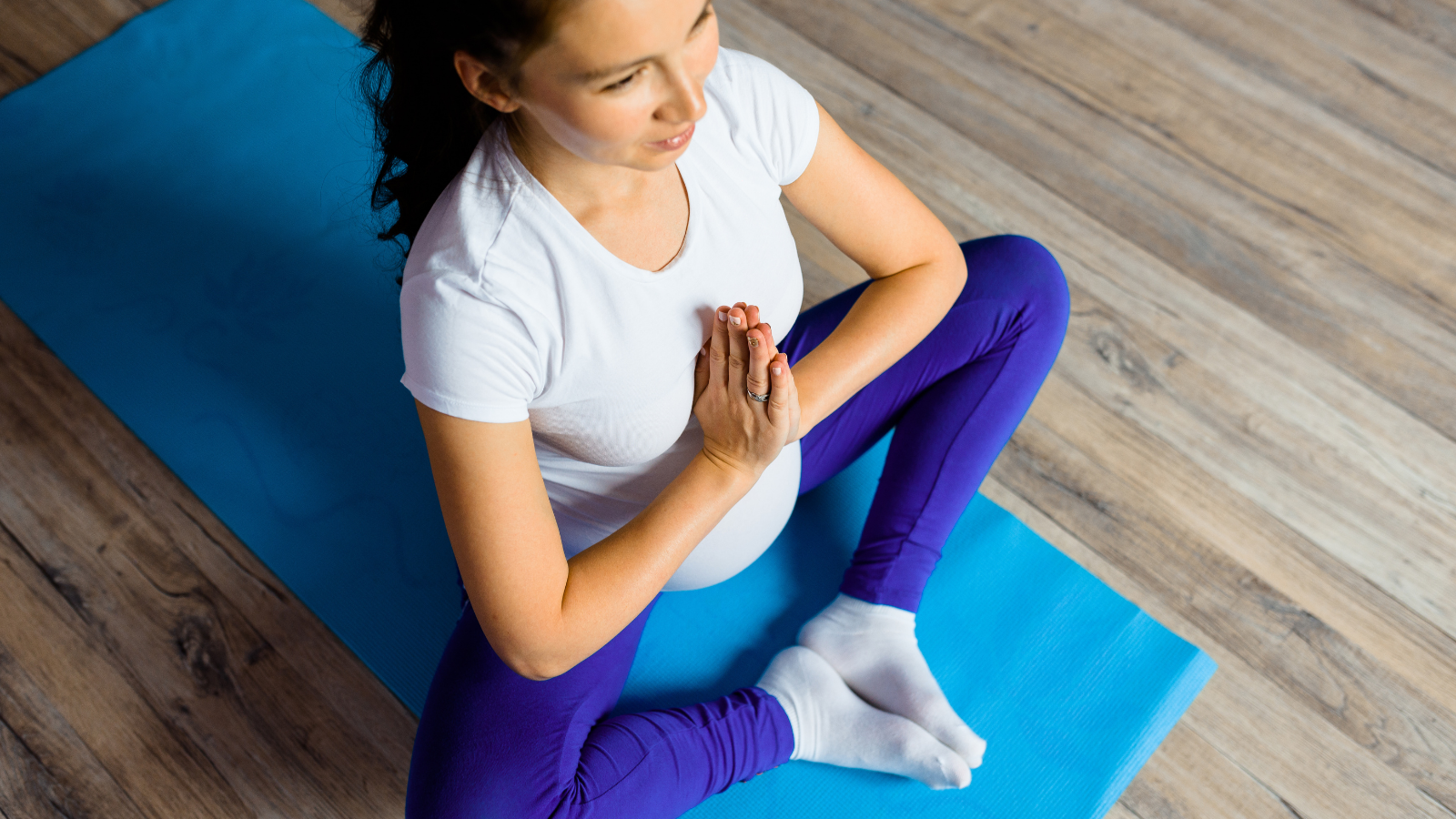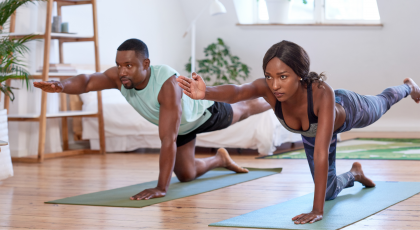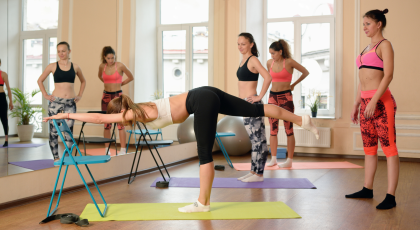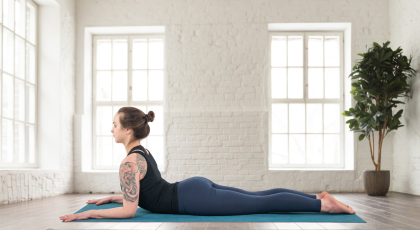View basket (0 items $0.00)

Prenatal Yoga to Help Prevent Shoulder and Wrist Discomfort
We often hear about achy backs, swollen ankles, and pressure around the pelvis during pregnancy. But what happens when pregnancy causes discomfort around the shoulders and wrists? This article explores the potential reasons behind the occurrence of shoulder and wrist pain during pregnancy, and it provides suggestions for preventing these two sometimes co-occurring sources of discomfort.
Shoulder Discomfort During Pregnancy

During pregnancy, shoulder discomfort may be caused by a variety of reasons. In most cases, discomfort around the shoulders should not be a serious cause for concern. Not only does the hormone relaxin loosen ligaments in the pelvis, but it also softens ligaments and joints throughout the body. The impact of relaxin may combine with the effect of increasing breast size, increasing weight of the abdomen, postural changes, and changes in sleep position to cause shoulder discomfort.
Shoulder discomfort during pregnancy may be felt most often on the left side due to sleep position. This may be true because pregnant people are often instructed to sleep on their left side for optimal circulation. More research is needed to determine whether sleep position causes shoulder pain during pregnancy. However, a cross-sectional study of adults seeking chiropractic care found that patients with unilateral shoulder pain were more likely to sleep on the side of the painful shoulder than on the pain-free side (1). This suggests that sleep position might impact shoulder pain.
Only rarely, shoulder pain during pregnancy may be a sign of a more serious underlying issue. For example, people with preeclampsia (a complication of pregnancy characterized by high blood pressure) may experience referred pain in the shoulder that radiates from the liver. Additionally, an ectopic pregnancy (which occurs when a fertilized egg implants in the fallopian tube) might be felt as pain in the tip of the shoulder between the fourth and twelfth week of pregnancy. Although shoulder pain is rarely a red flag, check with your provider if you are experiencing shoulder pain and have other symptoms of preeclampsia (such as severe headache, sudden swelling, vision changes, or dizziness) or ectopic pregnancy (such as vaginal bleeding, sharp abdominal cramps, or pain on one side of the body).
Wrist Discomfort During Pregnancy

Perhaps more than shoulder discomfort, discomfort in the wrists can be relatively common during pregnancy. Often, wrist sensitivity during pregnancy is related to carpal tunnel syndrome (CTS). In carpal tunnel syndrome, the median nerve, which runs from the brachial plexus (a nerve bundle that enters the arm through the armpit region) to the first three fingers in the hand, becomes compressed. This leads to numbness, weakness, tingling, burning, or pain in the hand.
One study found that among 100 pregnant women, 19 percent showed symptoms of carpal tunnel syndrome (2). Another study of 639 pregnant people, in Maternal Medicine, found the prevalence of carpal tunnel syndrome symptoms to be higher—around 34 percent (3). On the other hand, carpal tunnel syndrome occurs in as little as 4 percent of the general population. Like shoulder discomfort, carpal tunnel syndrome during pregnancy is thought to occur due to a variety of reasons. Swelling from the fluid retention that naturally occurs during pregnancy may be one common reason for the occurrence.
Sleep position may be another factor because the side-lying sleep position can, in some cases, compress the median nerve at the level of the shoulder. Although it hasn’t been explicitly studied in pregnancy, one case-control study found a strong and significant association between a preference for sleeping on the side and the presence of carpal tunnel syndrome in the general population of men and women under age 60 (4). Also, the previously mentioned study in Maternal Medicine showed that carpal tunnel syndrome in pregnancy may worsen sleep problems during the third trimester of pregnancy (3).
Common Causes of Pregnancy-Related Shoulder and Wrist Discomfort
Shoulder and wrist discomfort during pregnancy may occur together or separately during pregnancy. Additionally, in some instances, the hand and wrist discomfort of carpal tunnel syndrome can co-occur with muscle tension along the entire pathway of the median nerve, including the muscles in the neck, chest, shoulder, and arm.
Furthermore, sleep position may be associated with both shoulder and wrist discomfort during pregnancy. Although experts agree that it’s safest for pregnant people to sleep on their sides, not all side-lying positions are equal. Alignment in side-lying Relaxation Pose (Savasana), as described below, can be instructed in prenatal yoga classes so that pregnant people can practice positioning for pain-free, restful sleep.
How to Help Prevent Shoulder and Wrist Pain with Prenatal Yoga
If you are currently experiencing carpal tunnel syndrome or have a great deal of pain in the shoulders or wrists, you’ll want to skip these exercises for now. Once you are pain-free, these stretches and strengthening exercises may help to prevent wrist and shoulder pain from returning. For all others who are not currently experiencing wrist or shoulder pain, this short sequence may help to prevent shoulder and wrist discomfort during pregnancy. Try this short sequence:
Wrist Strengthening and Stretching

-
Come into a comfortable seat. Bring your hands into Prayer Position (Anjali Mudra) with your palms pressed together at your chest, fingers pointing upward. Turn the gesture upside-down, so that your fingers point downward, bringing the backs of the hands to touch while keeping your wrists in line with your elbows. If this feels like enough sensation in the wrists, you can hold here, otherwise, slowly make fists with your hands. After about two breaths, slowly release your fists. Repeat this twice more, making fists and slowly releasing, before gently separating your hands.
-
Next, to stretch the front of your wrists, bring your hands back into Anjali Mudra. Keep your palms connected this time as you flip the gesture downward, pointing your fingers down toward the ground. Hold for about 4 breaths before slowly releasing.
-
Finally, separate your hands and bring your fingers to touch your thumbs, making a beak shape with your hands. Imagine you’re moving your hands through thick molasses as you slowly separate your fingers from your thumbs. Then, continue to create resistance as you slowly bring your fingers back to touch your thumbs. Repeat this about 10 times, slowly opening and closing your hands.
Gentle Shoulder Mobility

-
Staying seated, interlace your hands in front of your chest. Extend your arms forward, and flip your palms to face away from your chest. On an inhalation, keep the interlace as you reach your extended arms upward. On an exhalation, gently round your upper back as you reach your arms back to their starting point. Repeat this movement for about 10 rounds of breath.
-
Next, release the interlace of your hands, and reach your arms overhead. On an exhalation, bend your arms into a goal post shape. Your elbows should be in the same line as your armpits, and your palms should face forward. On an inhalation, re-extend your arms overhead. Repeat this movement for about 10 rounds of breath.
-
Finally, take your arms into a goal post shape. On an exhalation, bring your elbows into your low ribs, making a W-shape with your arms. Your palms should still face forward, and you should feel your shoulder blades pinch inward. On an inhalation, return your arms into a goal post shape. Repeat this movement for about 10 rounds of breath.
Side-Lying Savasana

-
To set up for this version of side-lying Savasana, you’ll want three pillows or blankets. Lie down on your left side, setting the first pillow underneath your left cheek to support a neutral position of the cervical spine.
-
Stack your legs, and bend your knees so that they are in line with your hips. Set your second pillow in between your inner thighs to support the alignment of the hips and spine.
-
Finally, take your third pillow and hug it close to your chest and abdomen, in between your arms. Have your palms touching the pillow with your fingers in a neutral position rather than bent. Hugging the pillow will help to ensure that your wrists are not flexed or extended.
-
Stay in Savasana for 5 to 10 minutes, and replicate this position when you set up to sleep.
 Lacey Gibson Ramirez is a Boston-based ERYT-200 yoga teacher and a freelance writer. Through her teaching and writing, she seeks to make yoga accessible, inclusive, and equitable. Lacey has completed certifications in Prenatal Yoga and Barre as well as trauma-informed yoga trainings. Additionally, she holds a Masters of Science in Global Health and Population from Harvard T.H. Chan School of Public Health. To learn more and connect, visit her website laceygibson.com
Lacey Gibson Ramirez is a Boston-based ERYT-200 yoga teacher and a freelance writer. Through her teaching and writing, she seeks to make yoga accessible, inclusive, and equitable. Lacey has completed certifications in Prenatal Yoga and Barre as well as trauma-informed yoga trainings. Additionally, she holds a Masters of Science in Global Health and Population from Harvard T.H. Chan School of Public Health. To learn more and connect, visit her website laceygibson.com
References
-
Kempf, B., & Kongsted, A. (2012). Association Between the Side of Unilateral Shoulder Pain and Preferred Sleeping Position: A Cross-Sectional Study of 83 Danish Patients. Journal of Manipulative Physiological Therapy, 35(5), 407-12. Retrieved from https://pubmed.ncbi.nlm.nih.gov/22608285/
-
Khosrawi, S., & Maghrouri, R. (2012). The prevalence and severity of carpal tunnel syndrome during pregnancy, Advanced Biomedical Research, 1, 43. Retrieved from https://www.ncbi.nlm.nih.gov/pmc/articles/PMC3544091/
-
Meems, M., Truijens, S. E. M., Spek, V., Visser, L. H., & Pop, V. J. M. (2015). Prevalence, course, and determinants of carpal tunnel syndrome symptoms during pregnancy: A prospective study. Maternal Medicine. Retrieved from https://obgyn.onlinelibrary.wiley.com/doi/full/10.1111/1471-0528.13360
-
McCabe, S. J., Gupta, A., Tate, D. E., & Myers, J. (2011). Hand (N. Y.), 6(2), 132-137. Retrieved from https://www.ncbi.nlm.nih.gov/pmc/articles/PMC3092881/
Featured Courses









